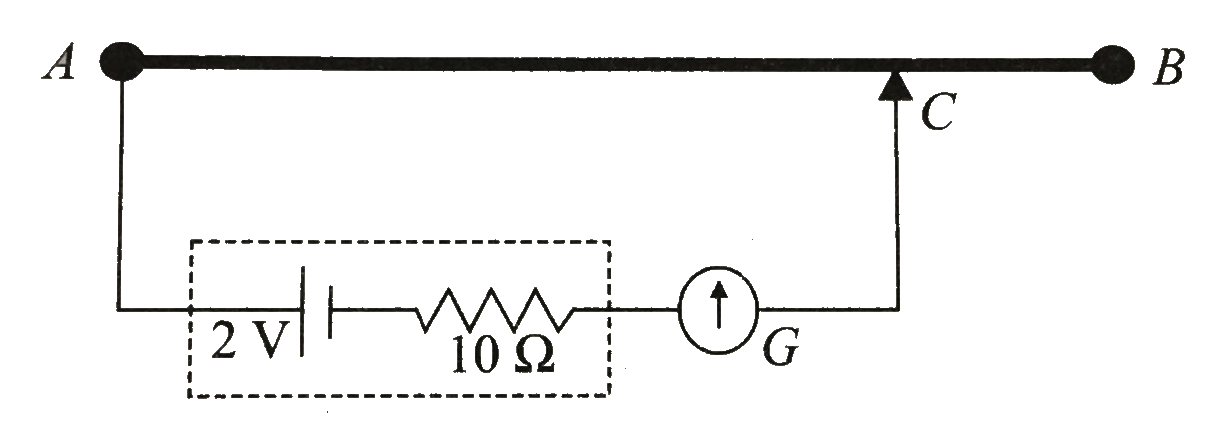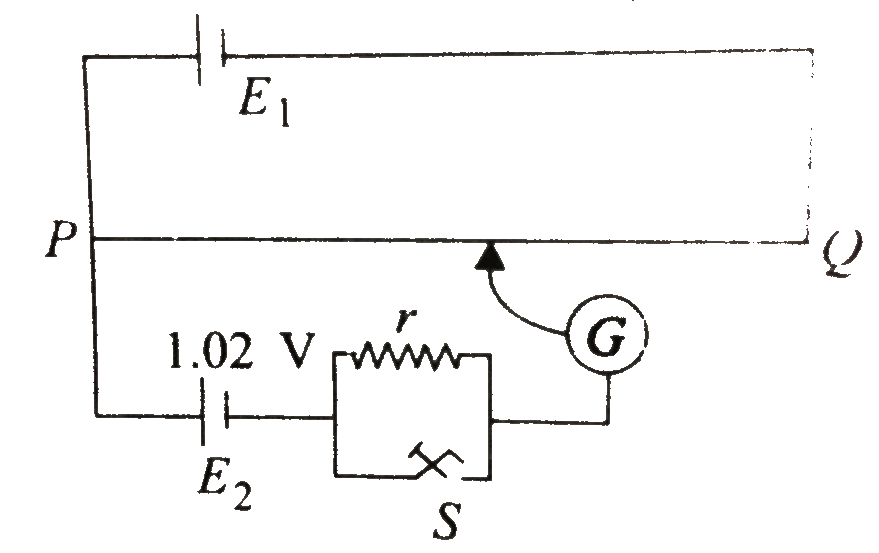The length of a potentiometer wire is 10 m and carries steady current on connecting the sliding jockey to standard cell of 1.018 volt, the null point is obtained at the distance of 850 cm.
The potential gradient along wire is:
1.2×10−2Vm−1
1.2×10−2V/cm
1.2×10−3Vcm−1
1.2×10−3Vcm
The correct Answer is:C
To find the potential gradient along the potentiometer wire, we will follow these steps:
Step 1: Understand the given data
- Length of the potentiometer wire (L) = 10 m
- EMF of the standard cell (E) = 1.018 V
- Distance at which the null point is obtained (d) = 850 cm = 8.5 m (since 1 m = 100 cm)
Step 2: Use the formula for potential gradient
The potential gradient (k) is defined as the potential difference (E) divided by the length (d) at which the null point is obtained. The formula is:
k=Ed
Step 3: Substitute the values into the formula
Now, substituting the values we have:
k=1.018V8.5m
Step 4: Calculate the potential gradient
Perform the calculation:
k=1.0188.5≈0.1197V/m
Step 5: Convert the result to the appropriate units
Since the options are in volts per centimeter, we need to convert volts per meter to volts per centimeter:
1V/m=0.01V/cm
Thus,
k≈0.1197V/m=0.1197×0.01V/cm=0.001197V/cm
Step 6: Express in scientific notation
To express this in scientific notation:
0.001197V/cm=1.197×10−3V/cm
Step 7: Round to significant figures
Rounding this to two significant figures gives:
k≈1.2×10−3V/cm
Conclusion
The potential gradient along the wire is:
Potential Gradient=1.2×10−3V/cm
- Length of the potentiometer wire (L) = 10 m
- EMF of the standard cell (E) = 1.018 V
- Distance at which the null point is obtained (d) = 850 cm = 8.5 m (since 1 m = 100 cm)
The potential gradient (k) is defined as the potential difference (E) divided by the length (d) at which the null point is obtained. The formula is:
k=Ed
Now, substituting the values we have:
k=1.018V8.5m
Perform the calculation:
k=1.0188.5≈0.1197V/m
Since the options are in volts per centimeter, we need to convert volts per meter to volts per centimeter:
1V/m=0.01V/cm
Thus,
k≈0.1197V/m=0.1197×0.01V/cm=0.001197V/cm
To express this in scientific notation:
0.001197V/cm=1.197×10−3V/cm
Rounding this to two significant figures gives:
k≈1.2×10−3V/cm
The potential gradient along the wire is:
Potential Gradient=1.2×10−3V/cm
Similar Questions
The length of a potentiometer wire is 600 cm and it carries a current of 40mA. For a cell of emf 2V and internal resistance 10Ω, the null point is found to be at 500cm. On connecting a voltmeter acros the cell, the balancing length is decreased by 10cm
The resistance of the voltmeter is
View SolutionThe length of a potentiometer wire is 600cm and it carries a current of 40mA. For a cell of emf 2V and internal resistance 10Ω, the null point is found to be ast 500cm. On connecting a voltmeter acros the cell, the balancing length is decreased by 10cm
The voltmeter reading will be
View SolutionThe length of a potentiometer wire is 600 cm and it carries a current of 40mA. For a cell of emf 2V and internal resistance 10Ω, the null point is found to be at 500cm. On connecting a voltmeter acros the cell, the balancing length is decreased by 10cm
The resistance of the voltmeter is
View SolutionThe potentiometer wire is of length 1200 cam and it carries a current of 60 mA. For a cell of emf 5V and internal resistance of 20Ω, the null point of it is found to be at 1000 cm.The resistance of potentiometer wire is
View SolutionThe length of a potentiometer wire AB is 600cm, and it carries a constant current of 40mA from A to B. For a cell of emf 2V and internal resistance 10Ω, the null point is found at 500cm from A. When a voltmeter is connected across the cell, the balancing length of the wire is decreased by 10cm.

Potential gradient along AB is
View SolutionA 10 m long potentiometer wire carries a steady current. A standard cell of emf 1.018 V is balanced against a length of 254.5 cm of the wire. What is the potential gradient across the potentiometer wire ?
View SolutionThe length of a potentiometer wire is 10m and a potential difference of 2 volt is applied to its ends. If the length of its wire is increased by 1m, the value of potential gradient in volt/m will be (potential difference across potentiometer wire remain same)
View SolutionPotentiometer wire PQ of 1m length is connected to a standard cell E1. Another cell E2 of emf 1.02V is connected with a resistance r and a switch S as shown in the circuit diagram. With switch S open, the null position is obtained at a distance of 51cm from P.
(i) Calculate the potential gradient of the potentiometer wire.
(ii) Find the emf of cell E1.
(iii) When switch S is closed, will the null point move toward P or toward Q? Give reason for your answer.

View SolutionThe length of potentiometer wire is 200 cm and the emf of standard cell is primary circuit is E volts. It is employed to a battery of emf 0.4 v the balance point is obtained at l = 40 cm from positive end, the E of the battery is (cell in primary is ideal and series resistance is zone
View SolutionThe length of the potentiometer wire is 600 cm and a current of 40 mA is flowing in it. When a cell of emf 2 V and internal resistance 10Ω is balanced on this potentiometer the balance length is found to be 500 cm. The resistance of potentiometer wire will be
View Solution
